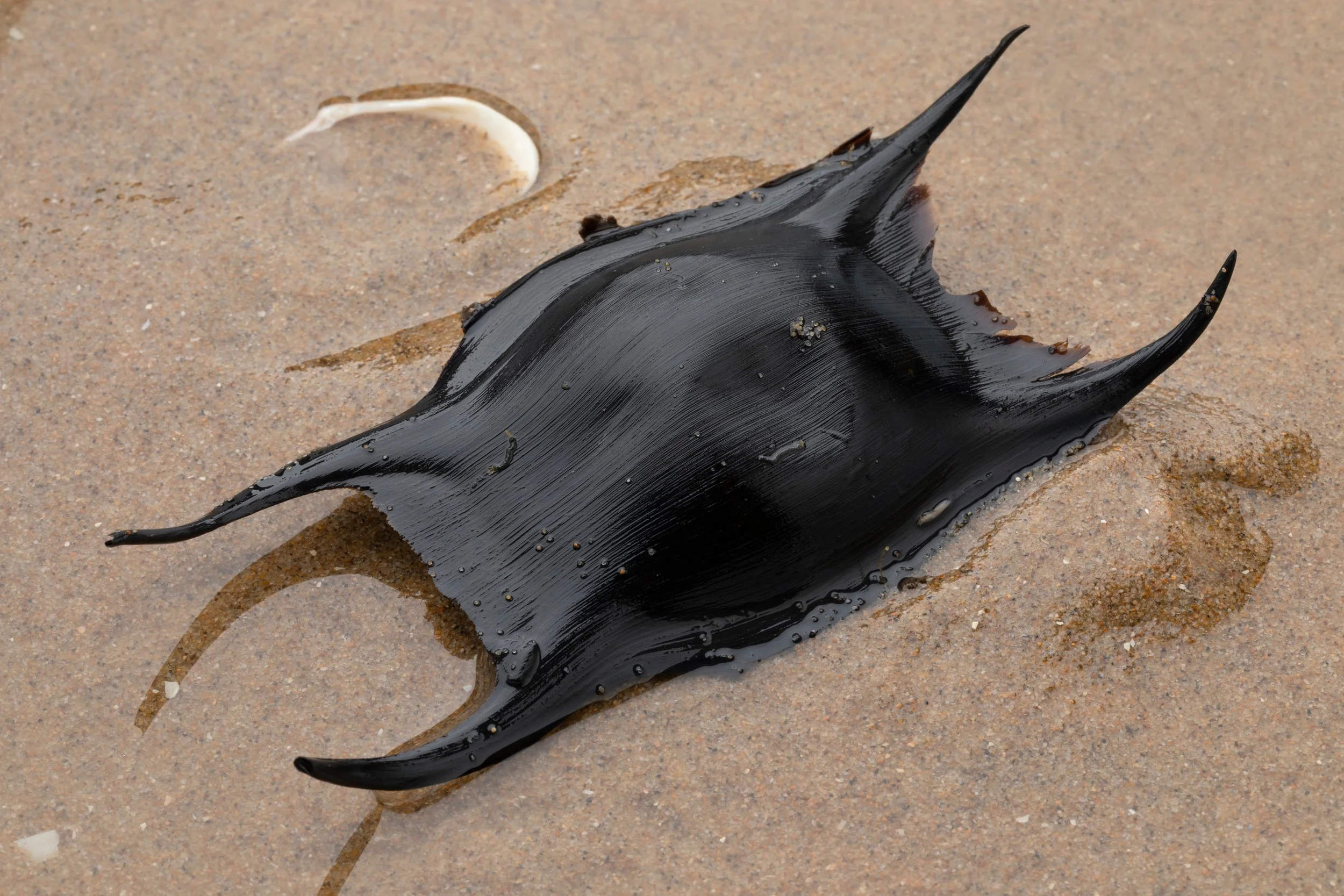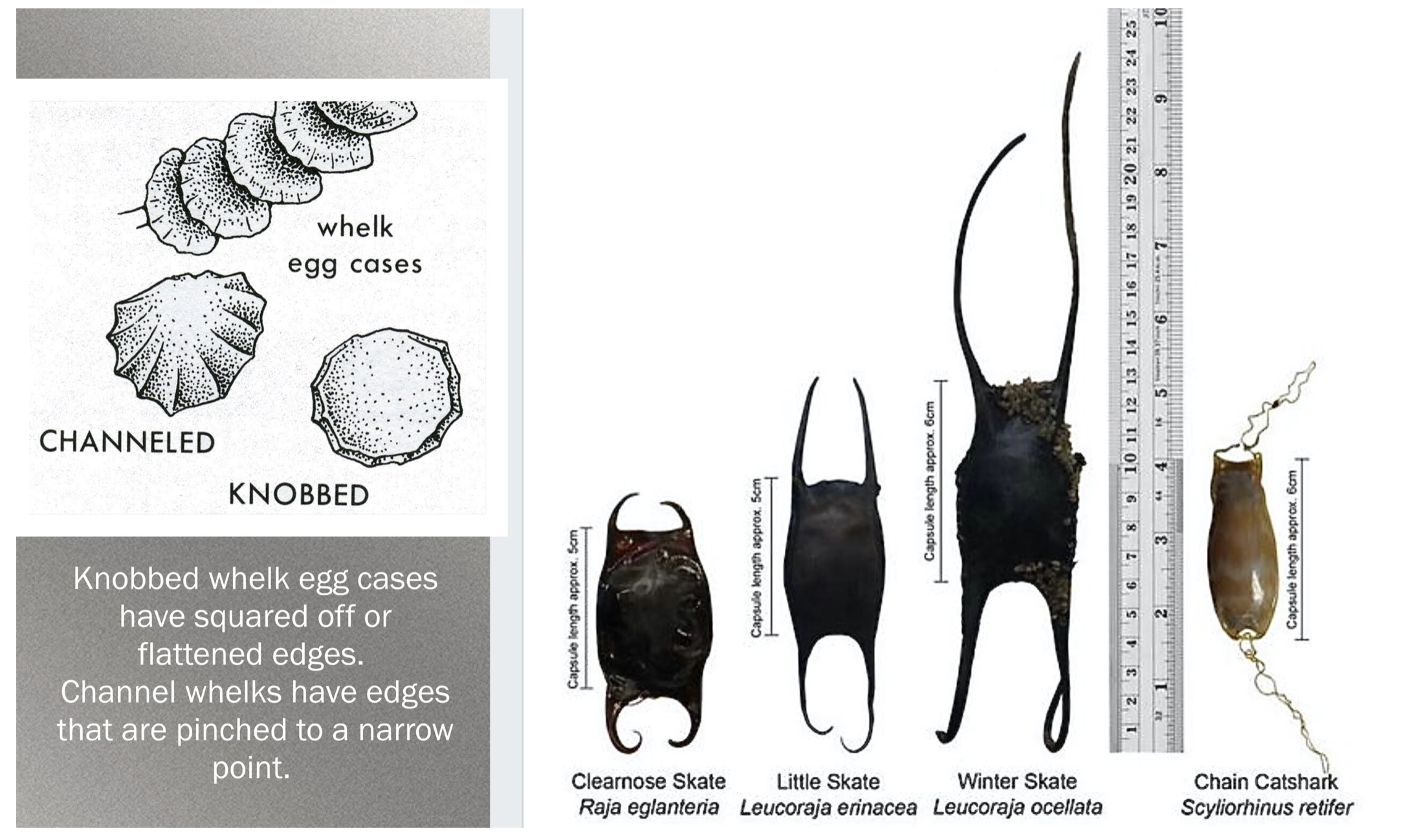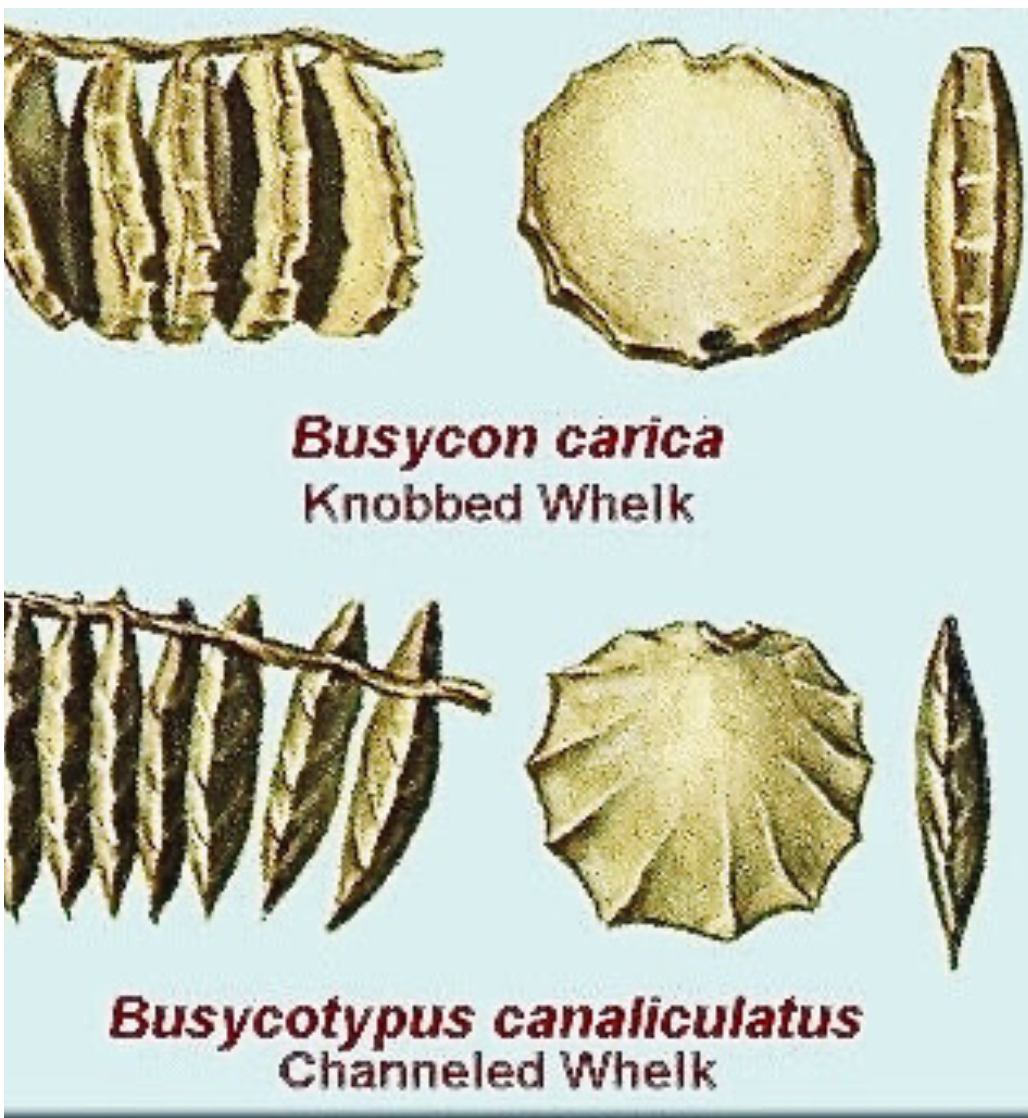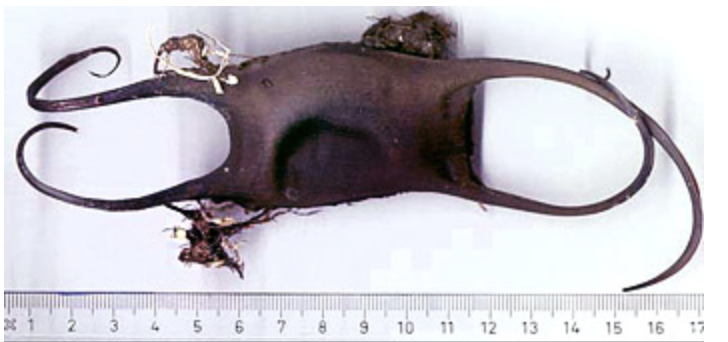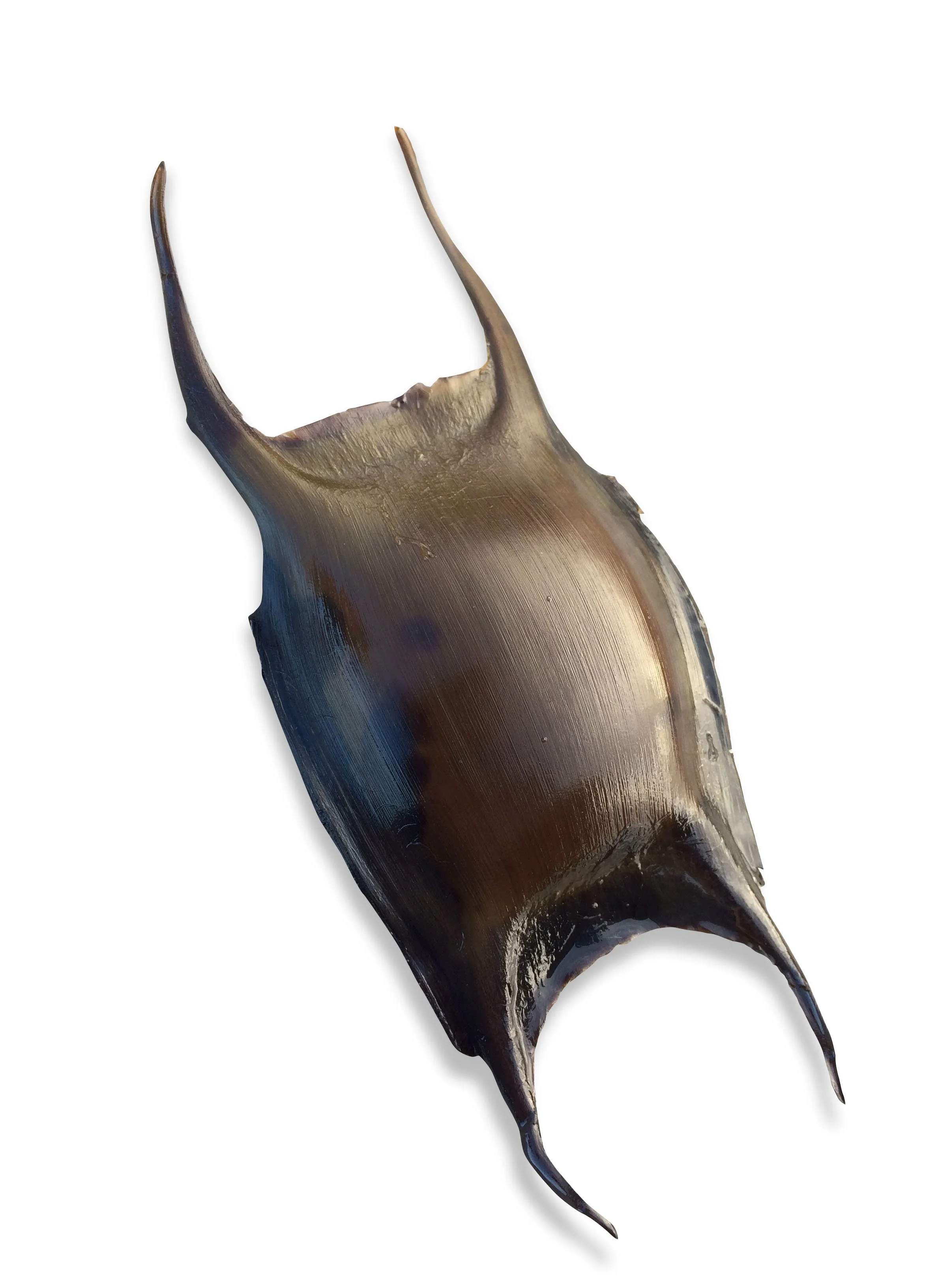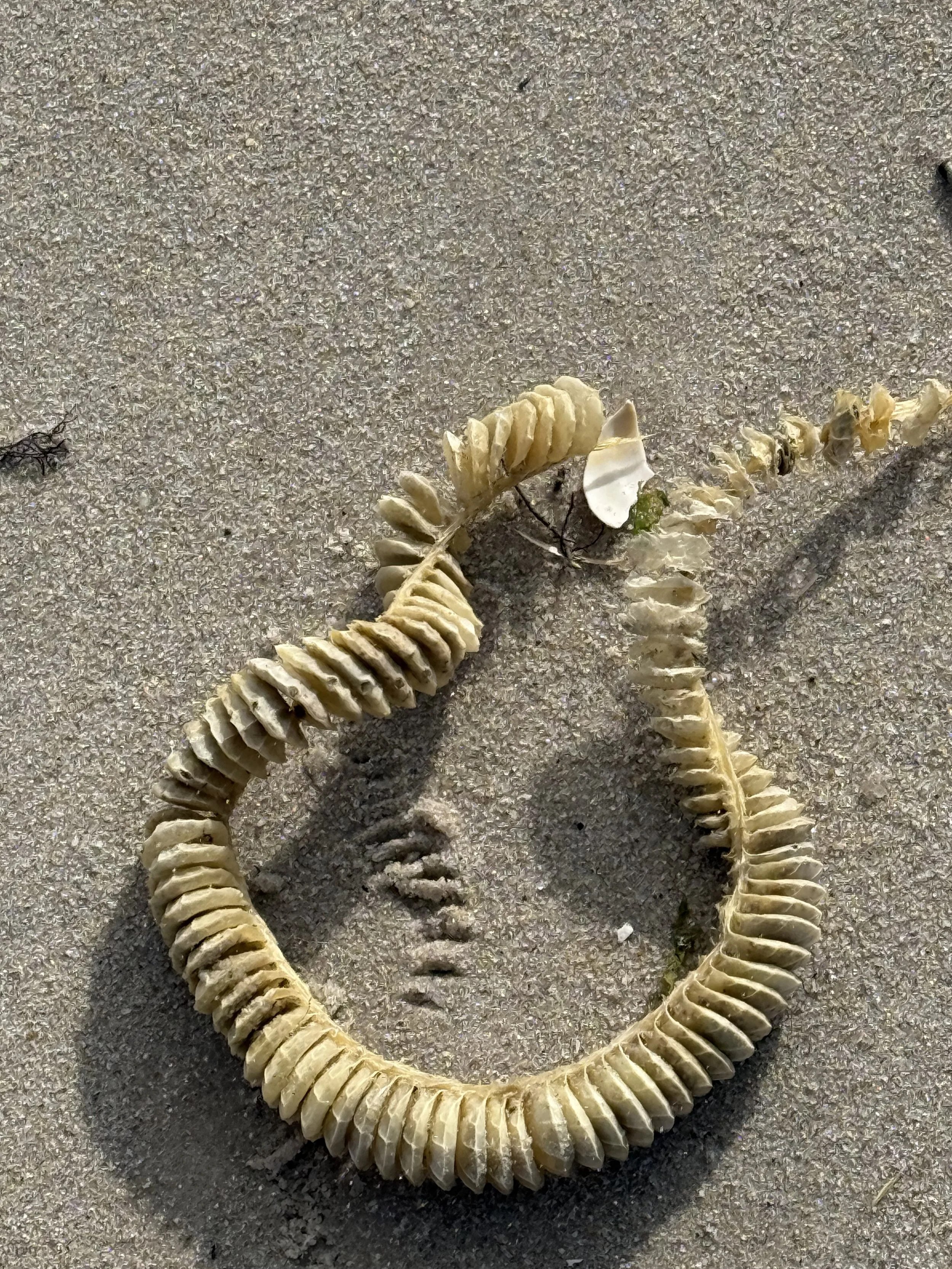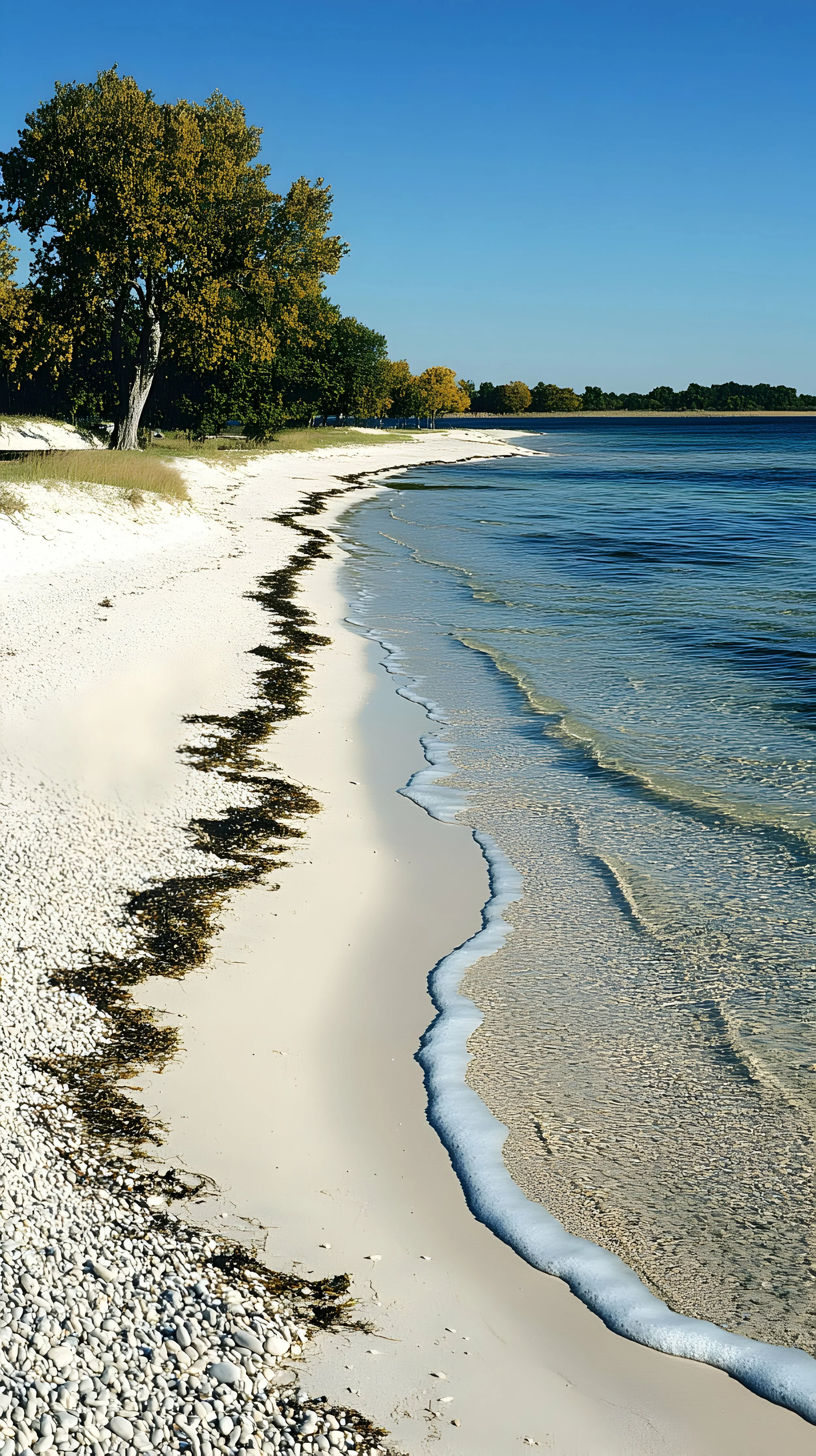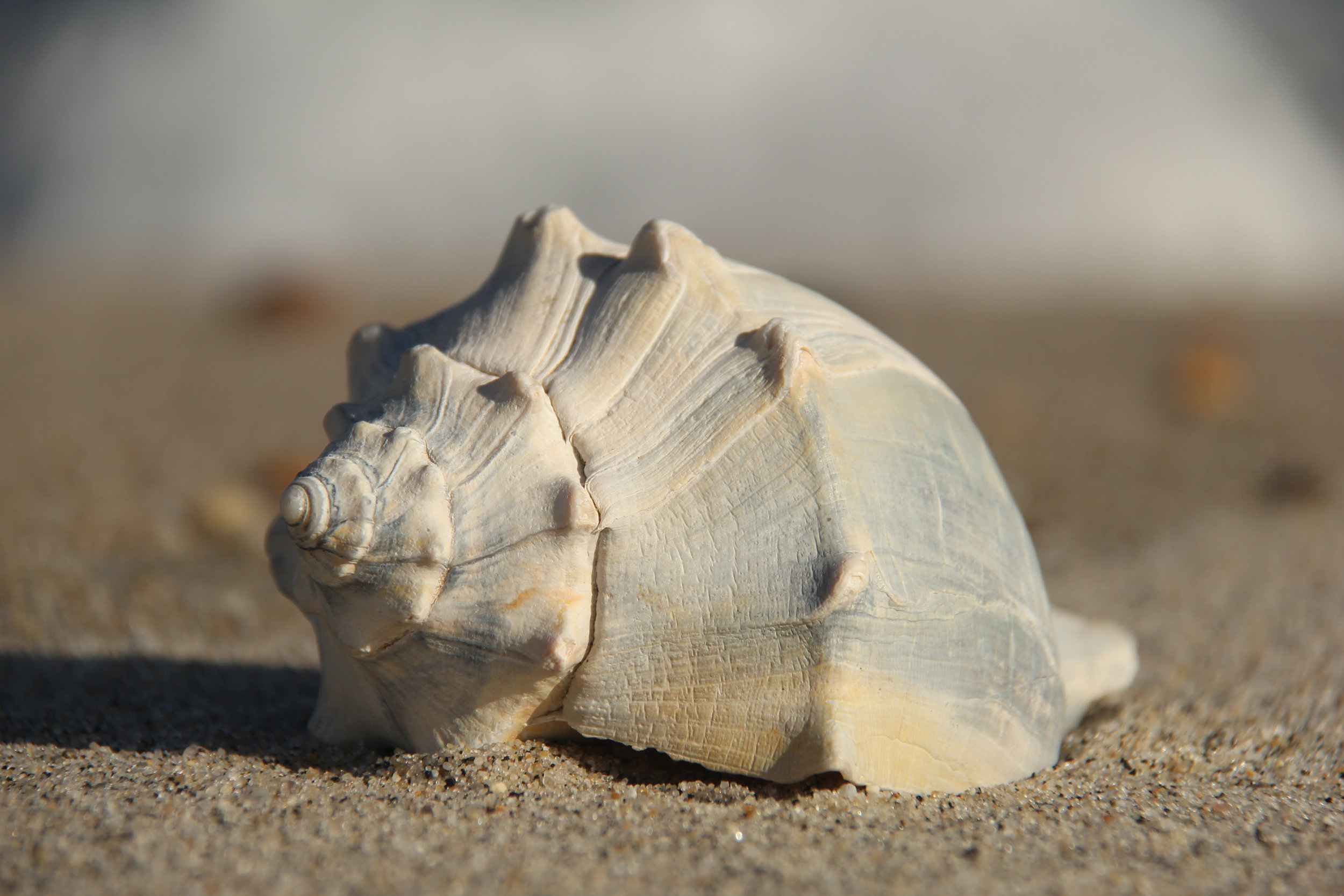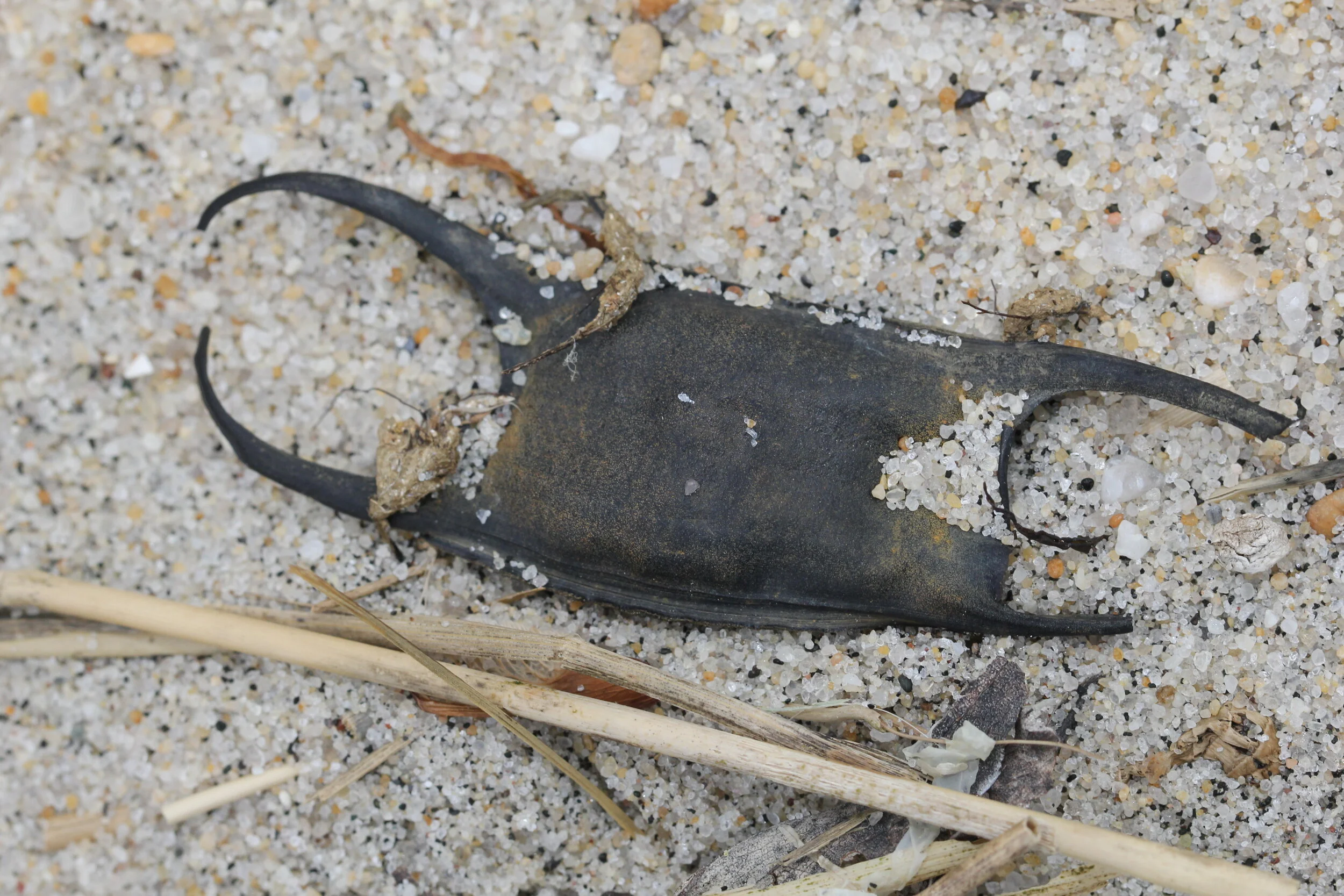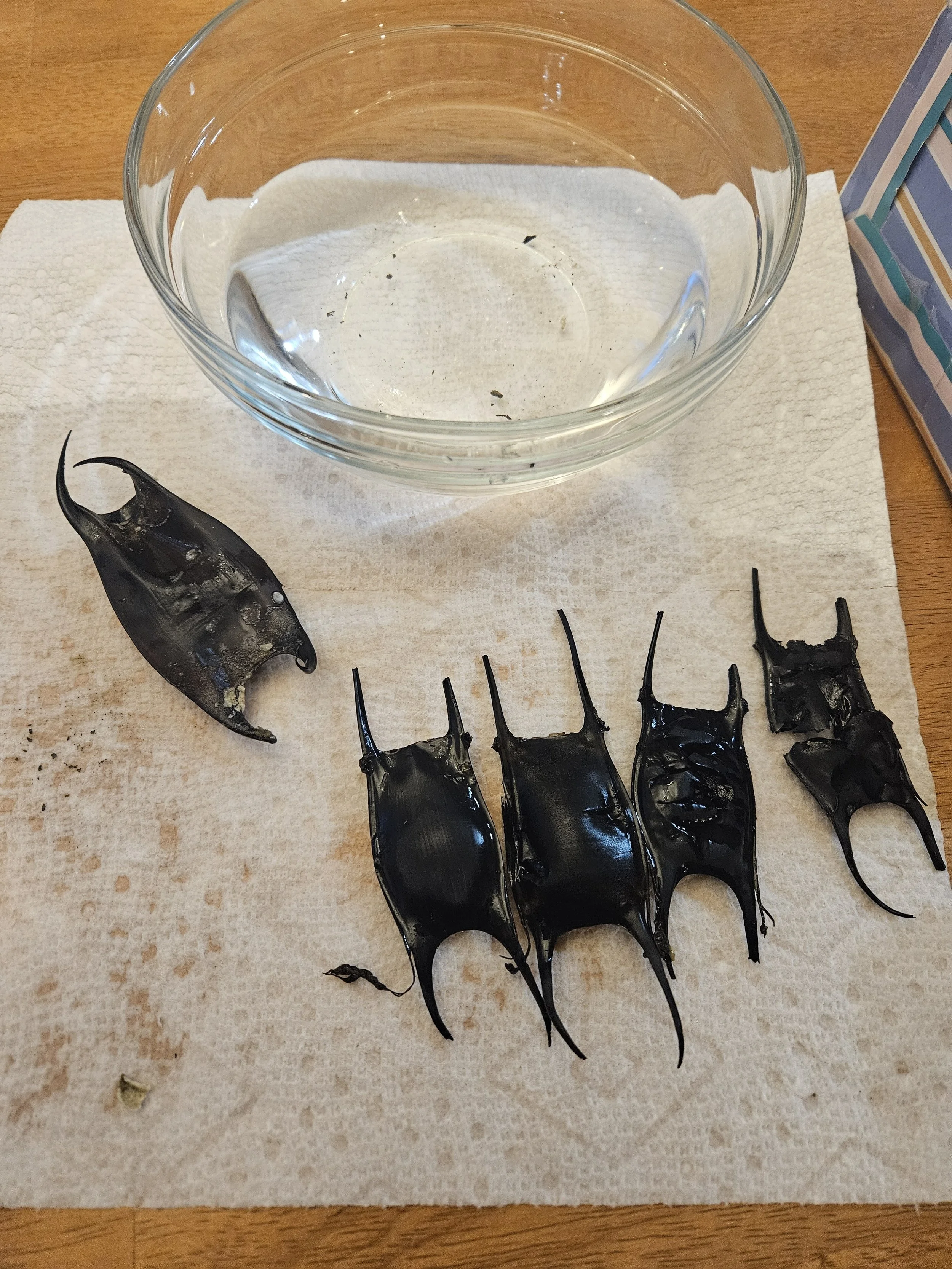The Great Spring Skate & Whelk Egg Case Hunt!
Every March, April and May, explore a springtime beach and become a community scientist by helping Save Coastal Wildlife Nonprofit find and record Skate or Whelk egg cases!
WE NEED YOUR HELP!
Populations of various species of skates and whelks along the Jersey Shore are largely unknown at best or decreasing at worst.
Help Save Coastal Wildlife Nonprofit this spring by recording your find of a skate or whelk egg case along the Jersey Shore. Empty egg cases can help indicate species presence and diversity in nearby waters. By recording your finds, you're helping us to discover more about egg-laying species in local waters. Empty egg cases from skates, whelks, and even sharks can help indicate species presence and diversity along the Jersey Shore.
Unfortunately, it doesn’t take much time or effort for an animal to become threatened or endangered. Once it does, it can take decades or more for a species to recover, if ever. One of best times to start protecting an animal is when threats are known. Waiting until a specie’s population is dwindling might be too late. Since many species of skates found along the Jersey Shore are commercially unimportant, their true conservation status is poorly known.
How to Identify Your Skate Egg Case!
〰️
How to Identify Your Skate Egg Case! 〰️
Congratulations!
You found an egg case!
So how do you identify and record your find?
First off you will have to prepare your egg case to be identified.
At home, please prepare your egg case by rehydrating it in a bucket or a container of water. This makes an egg case easier to identify. An egg case truly belongs in the water, not dried out on a beach from the sun and wind. You’ll see how much a skate egg case expands to its true size.
Step 1: Fill a container with tap water.
Step 2: Put the egg case in the water – if possible try to remove all the air so it sinks.
Step 3: Leave it in the water to soak for 1 to 6 hours - the longer it’s been out of water, the longer it will need to be in the water.
Step 4: Remove the egg case from the water & start identifying your find (see below).
Step 5: Record your egg case find with Save Coastal Wildlife Nonprofit (click the orange button)
Skate identification is from Assateague Island National Seashore.
Egg cases of the barndoor skate (left) the thorny skate (middle) and the winter skate (right). Picture from https://www.semanticscholar.org/
Common Skates & Whelks Along the Jersey Shore
Image from Wikipedia
Little Skate
(Leucoraja erinacea)
The color of the egg case is amber or golden yellow when laid, but is usually black when found empty. The average size ranges from 2.1 -2.4 inches long (excluding the horns) by 1.3 - 1.7 inches wide. One side of the egg case will have a longer pair of horns. The horns of both sides will taper to slender tips, so fragile that they ordinarily break apart when found. The longer horns are nearly straight, the shorter pair more or less curved, one toward the other.
Above drawings of a clearnose skate egg case is from Fishes of the Western Atlantic, Sawfishes, Guitarfishes, Skates, Rays Chimaeroids, by Henry B. Bigelow and William C. Schroeder, originally published in 1953 by Sears Foundation for Marine Research, Yale University.
Knobbed Whelk
(Busycon carica)
Adults lay their distinctive egg cases near the low tide line. Their eggs may be described as a stack of checkers with jagged, somewhat squared-off edges in an accordion-like belt.
Clearnose Skate
(Raja eglanteria)
The egg case, which usually is black in color, ranges in size from 2 - 3.5 inches long (without the horns), and 1.5 to 2.2 inches wide. The horns are almost always shorter than the egg case itself. Egg cases farther south, such as in Florida, are generally smaller than those found in New Jersey, New York and Massachusetts. Incubation of the baby skate inside is normally a period of three months, but it could vary. There is still much we do not know about the skate incubation period.
Image from Florida Museum of Natural History
Channel Whelk
(Busycotypus canaliculatus)
Adults lay eggs in the intertidal to the shallow sub-tidal depths. Egg cases sort of resemble a stack of miniature compact discs with thin edges in an accordion-like belt.
A break in the channel whelk egg case where the young whelks exit
Winter Skate
(Leucoraja ocellata)
The color of the egg case varies from black-gray to greenish brown or brownish olive. Sizes range from 2.1 - 3.8 inches long by 1.3 - 2.0 inches wide, excluding the horns. Northern egg cases average larger than southern egg cases. One end of the egg case has shorter horns that are usually concave. The side with the longer horns are usually straight to somewhat bending. The longer horns are normally 1.5 times as long as the shorter pair, and about 1.5 times as long as the egg case, but the tips are fragile and generally have broken off when found.
What’s an egg case?
All skates and whelks reproduce by laying an egg case.
Skates lay black leather pouches often called mermaid purses.
Whelks lay yellowish-tan rounded egg capsules joined to form a chain that is sometimes called a mermaid’s necklace.
Skate egg cases are surrounded by a tough leathery capsule that protects the embryo as it develops inside. After several months these are ready to hatch, and a fully-formed skate will emerge.
Skates lay egg cases, all rays give birth to live young. Some species of sharks also lay egg cases, while others give birth to live young. Once empty, the eggcases (or mermaid’s purses) often wash up on the beach.
Whelks mate and lay or produce egg cases during the spring and fall migration. Internally fertilized eggs are laid in a protective flat, rounded egg capsules joined to form a paper-like chain of egg cases, commonly called a "Mermaid's Necklace". Some people also describe them as a stack of small crackers that are coiled together in an accordion-like belt.
On average each capsule contains 1-99 eggs, with most strings having 40-160 capsules. After laying their egg cases, female whelks will bury one end of the egg case into the substrate, thus providing an anchor for the developing fertilized eggs and preventing the string of egg cases from washing ashore where it would dehydrate. Fertilized eggs develop in the capsules.
Where can I find an Egg Case?
During low tide or after a storm are some of the best times to look for an egg case on a coastal beach.
One of the best places to find an egg case on a coastal beach is among the strand-line or tide-line, where seaweed, debris and remains of dead life washed up from the previous high tide.
Of course, egg cases may wash up anytime of the year. It doesn’t have to be in the spring to look and record your egg case finds.
Test your coastal naturalist skills. See how many egg cases you can find and identify every year!
THREATS TO SKATES & WHELKS
Skates are a type of fish that are closely related to the rays and more distantly related to sharks.
The skates are the most diverse lineage of the cartilaginous fishes (sharks, skates, and rays).
The term ‘cartilaginous fishes’ refers to the fact that these groups do not have true bone and instead have skeletons made of hardened cartilage.
The skates are under constant threat along the northwestern Atlantic Ocean from bycatch due to commercial fisheries that employ bottom trawling nets used to target species of fish, but often take up other species in their huge fishing nets. Skates, like sharks and rays, are slow growing and late to mature, produce few young, and may not reproduce every year, plus they are bottom feeders particularly at night. All this makes skates especially vulnerable to a population decline from bycatch.
During the 1960s and 1970s, barndoor skates (Dipturus laevis) were depleted by commercial fisheries as bycatch. Bottom fisheries that targeted Atlantic cod and other species accidentally captured a large number of barndoor skates. This caused numbers to drop quickly. Conservation efforts that began in the 1990s have succeeded in increasing numbers, but scientists still consider this species to be endangered.
For example…
These threats from commercial fishing may be causing the distribution of different skate and whelk species to change along the Jersey Shore, and population numbers for certain species may be weakened.
By taking part in the Great Spring Skate & Whelk Egg Case Hunt you are helping Save Coastal Wildlife Nonprofit to identify problems early. Egg cases may indicate that nursery grounds are nearby and can assist in the conservation of skates and whelks. Your egg case records are a crucial element of local conservation.
Whelks, a type of mollusk and sea snail, are increasingly under threat and in demand by local commercial fishermen for overseas markets in Europe and Asia. If you ever had a plate of scungilli, then you were eating a whelk. Commercial fisheries are putting pressure on populations of this sea snail at a localized risk of collapse along the Jersey Shore. The annual dockside value of the whelk catch now tops $1 million in Virginia and Rhode Island, $1.4 million in New Jersey and $5.7 million in Massachusetts, according to marine fishery agencies in those states. In Delaware, knobbed and channeled whelks are now the third most valuable fishery behind blue crabs and striped bass.
Thank you to everyone who has taken part in the Great Spring Skate & Whelk Eggcase Hunt!
In March 2025, a volunteer with Save Coastal Wildlife discovered several skate egg cases on a beach in Mantoloking, NJ. The egg cases are from all three species of skates common to the Jersey Shore: Clearnose skate (top), winter skate (middle, second from the left), and three Little skates.



